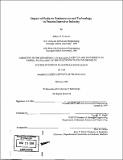Impact of scale on performance and technology in process-intensive industry
Author(s)
Nystrom, Jeffrey D. (Jeffrey David), 1970-
DownloadFull printable version (5.854Mb)
Other Contributors
Massachusetts Institute of Technology. Dept. of Materials Science and Engineering.
Advisor
Thomas W. Eagar.
Terms of use
Metadata
Show full item recordAbstract
Two surveys are performed to determine production methods, competitive strategies, and scale disadvantages for a group of small manufacturing plants. Detailed comparisons of economic, operational, and development activities are presented to identify differences between industry production standards and small-scale plants. As a group, the small-scale plants had similar production costs to the standard-scale plants. The small-scale plants experienced lower average unit fixed costs as a result of lower capital investment and indirect labor expenses. The small-scale plants operated closer to their theoretical efficiency levels than the standard-scale plants. The procedure used to collect and analyze data is referred to as the direct comparison method. The direct comparison method involves conducting detailed one-to-one comparisons of production systems at the plant-level. A pattern of operational trends are reported that contribute to the economic performance of small-scale plants. The small-scale plants compensated for scale disadvantages by having greater technology independence, conserving capital, conducting internal development, and promoting process competence.
Description
Thesis (Sc.D.)--Massachusetts Institute of Technology, Dept. of Materials Science and Engineering, 1999. "February 2000." Includes bibliographical references (p. 113-116).
Date issued
1999Department
Massachusetts Institute of Technology. Department of Materials Science and EngineeringPublisher
Massachusetts Institute of Technology
Keywords
Materials Science and Engineering.